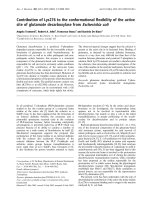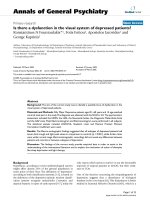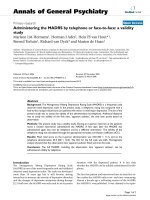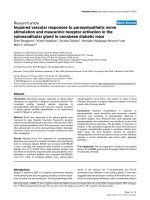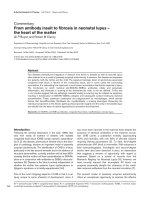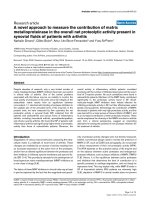Báo cáo y học: "Is the way to man’s heart (and lung) through the abdomen" doc
Bạn đang xem bản rút gọn của tài liệu. Xem và tải ngay bản đầy đủ của tài liệu tại đây (44.55 KB, 2 trang )
Available online />Page 1 of 2
(page number not for citation purposes)
Abstract
Intra-abdominal hypertension is increasingly recognized to be both
prevalent and clinically important in medical and surgical intensive
care units. Intra-abdominal pressure (IAP) can impact organ
function throughout the body, and it can also complicate standard
measurements used in intensive care units. The article by Krebs
and colleagues reports the effect of IAP on respiratory function,
gas exchange and hemodynamic function. Their results show a
relatively small effect of modestly elevated IAP on these variables in
their patient population. However, their work raises several
questions for clinicians and researchers regarding the patho-
physiology and management of IAP.
In the previous issue of Critical Care, Krebs and colleagues
systematically studied the effects of intra-abdominal hyper-
tension (IAH) on cardiopulmonary function [1]. Such studies
are very much needed for a number of reasons. Traditionally,
trauma surgeons witnessed improvements in urinary output
following laparatomy; but medical intensivists were slower to
appreciate the importance of intra-abdominal pressure (IAP).
IAH is highly prevalent, however, in both surgical and medical
intensive care units [2], although the causes may differ. IAH
may become an even greater issue in the medical intensive
care unit with the obesity pandemic, since body mass index is
the best independent predictor of IAP [2].
Furthermore, several studies have shown that IAH has prog-
nostic importance through effects on both intra-abdominal
and intrathoracic organ function [3]. That is, increased IAP
causes pleural pressure elevations that affect cardio-
pulmonary function [4]. Hepatic and renal compromise has
been reported, presumably through compression of venules.
We have previously observed patients with presumed
hepatorenal syndrome (a diagnosis with ostensibly up to
100% mortality) who were markedly improved by lowering
IAP via paracentesis, suggesting IAH as a cause for their
renal failure [5]. In addition, marked elevations in intracranial
pressure have been observed with increasing IAP,
presumably through reductions in venous return from the
head [6]. Beyond these end organ effects, elevations in IAP
can also impact measurement of respiratory and hemo-
dynamic parameters [7]. For example, the central venous
pressure – typically measured with reference to atmosphere –
can be elevated in patients with IAH. These elevated values
of central venous pressure do not reflect excess preload,
however, but instead reflect external compression of the right
atrium (by elevated pleural pressure in the setting of IAH) that
raises central venous pressure even with very little volume
within the atrium. Based on the appreciation of the
importance of IAP, there is now renewed interest in the
measurement of intrathoracic pressure.
How to incorporate these pressure measurements into
clinical practice raises several issues. First, the use of
esophageal pressure to estimate pleural pressure has been
questioned [8], since elevated values were presumed to be
an artifact of cardiac weight. Sustained elevations in pleural
pressure would imply negative transpulmonary pressure
(classically defined as airway opening pressure minus pleural
pressure [9]), which some individuals have argued cannot
occur. These negative values (pleural pressure in excess of
the airway opening pressure) are routinely seen during forced
exhalation, however, and are commonly observed with the
development of atelectasis, airway closure, alveolar flooding
and/or expiratory flow limitation [10].
Second, the slope of a pressure–volume curve reflects the
compliance (or elastance) of the respiratory system, regard-
less of the position of the curve [11]. That is, we have
Commentary
Is the way to man’s heart (and lung) through the abdomen?
Robert L Owens
1
, R Scott Harris
2
and Atul Malhotra
1
1
Sleep Disorders Research Program, Division of Sleep Medicine, Brigham and Women’s Hospital and Harvard Medical School,
221 Longwood Avenue, Boston, MA 02115, USA
2
Department of Medicine, Pulmonary and Critical Care Unit, Bulfinch 148, Massachusetts General Hospital and Harvard Medical School, Boston,
MA 02114, USA
Corresponding author: Robert L Owens,
Published: 6 November 2009 Critical Care 2009, 13:199 (doi:10.1186/cc8136)
This article is online at />© 2009 BioMed Central Ltd
See related research by Krebs et al., />IAH = intra-abdominal hypertension; IAP = intra-abdominal pressure.
Critical Care Vol 13 No 6 Owens et al.
Page 2 of 2
(page number not for citation purposes)
observed normal respiratory system compliance in obesity,
despite markedly shifted curves (baseline pleural pressure
elevations but a normal slope) [10,12,13]. Both the slope and
the pressure intercept of the pressure–volume curve are
therefore needed to define the mechanical behavior of the
respiratory system.
Third, the transmission of IAP to the thorax may depend on
the disease state and/or chronicity. As such, it is unknown
whether acute elevations in IAP (as seen in trauma or surgical
intensive care unit patients) would have the same impact on
intrathoracic pressures as would chronic elevations (due to
obesity or cirrhosis with ascites, for example), since
diaphragm remodeling may occur over time [14]. Moreover, in
nonparalyzed patients, ongoing diaphragmatic activity could
attenuate pressure transmission from the abdomen to the
thorax. Careful attention to these physiological issues is
required when examining the clinical literature.
In their study, Krebs and colleagues report minimal effect of
IAP on respiratory function, gas exchange, and hemodynamic
function. The findings are very interesting and somewhat
surprising. The lack of observed effect of IAP on pleural
pressure may reflect the relatively modest elevations in IAP. In
addition, given that these IAH patients were primarily surgical
and were relatively lean (by US standards), the findings may
have been different in more obese patients with more marked
and sustained elevations in abdominal (and thus pleural)
pressure. In addition, we are unclear as to whether ongoing
diaphragmatic activity was present in this study – which may
have increased the tension across the diaphragm and
perhaps minimized the influence of IAP on pleural pressure.
These results raise some important issues. For the clinician,
the take-home message from the present paper might be that
the correlation between IAP and pleural pressure is poor
within the range studied, necessitating direct measurement of
intrathoracic pressure if this value is required. Further work
will be necessary to determine the utility of these measure-
ments in influencing patient outcome, particularly in patients
with acute respiratory distress syndrome [15,16]. In the
Krebs and colleagues study population, more marked IAP
elevations may be required to have an important clinical
impact. For the scientist, careful studies on diaphragm
remodeling in the setting of obesity and critical illness would
be of interest. In addition, regional variations in pleural
pressure and their influences on local pulmonary mechanics
should be assessed. Finally, although cardiac weight has only
a minor effect on esophageal pressure measurements in
normal subjects [17], further validation of these techniques in
critically ill patients would be of interest.
Competing interests
The authors declare that they have no competing interests.
References
1. Krebs J, Pelosi P, Tsagogiorgas C, Alb M, Luecke T: Effects of
positive end-expiratory pressure on respiratory function and
hemodynamics in patients with acute respiratory failure with
and without intra-abdominal hypertension: a pilot study. Crit
Care 2009, 13:R160.
2. Malbrain ML, Chiumello D, Pelosi P, Wilmer A, Brienza N, Mal-
cangi V, Bihari D, Innes R, Cohen J, Singer P, Japiassu A, Kurtop
E, De Keulenaer BL, Daelemans R, Del Turco M, Cosimini P,
Ranieri M, Jacquet L, Laterre PF, Gattinoni L: Prevalence of intra-
abdominal hypertension in critically ill patients: a multicentre
epidemiological study. Intensive Care Med 2004, 30:822-829.
3. Malbrain ML, Chiumello D, Pelosi P, Bihari D, Innes R, Ranieri VM,
Del Turco M, Wilmer A, Brienza N, Malcangi V, Cohen J, Japiassu
A, De Keulenaer BL, Daelemans R, Jacquet L, Laterre PF, Frank
G, de Souza P, Cesana B, Gattinoni L: Incidence and prognosis
of intraabdominal hypertension in a mixed population of criti-
cally ill patients: a multiple-center epidemiological study. Crit
Care Med 2005, 33:315-322.
4. Malhotra A, Hillman D: Obesity and the lung: 3. Obesity, respi-
ration and intensive care. Thorax 2008, 63:925-931.
5. Jain D, Dorairajan S, Misra M: Ascites, a new cause for bilateral
hydronephrosis: case report. ScientificWorldJournal 2009, 9:
1035-1039.
6. De laet I, Citerio G, Malbrain ML: The influence of intraabdomi-
nal hypertension on the central nervous system: current
insights and clinical recommendations, is it all in the head?
Acta Clin Belg Suppl 2007, 1:89-97.
7. Gilroy RJ, Jr, Lavietes MH, Loring SH, Mangura BT, Mead J: Res-
piratory mechanical effects of abdominal distension. J Appl
Physiol 1985, 58:1997-2003.
8. Hager DN, Brower RG: Customizing lung-protective mechani-
cal ventilation strategies. Crit Care Med 2006, 34:1554-1555.
9. Mead J, Takishima T, Leith D: Stress distribution in lungs: a
model of pulmonary elasticity. J Appl Physiol 1970, 28:596-
608.
10. Talmor D, Sarge T, O’Donnell CR, Ritz R, Malhotra A, Lisbon A,
Loring SH: Esophageal and transpulmonary pressures in
acute respiratory failure. Crit Care Med 2006, 34:1389-1394.
11. Harris RS, Hess DR, Venegas JG: An objective analysis of the
pressure–volume curve in the acute respiratory distress syn-
drome. Am J Respir Crit Care Med 2000, 161:432-439.
12. Owens RL, Hess DR, Malhotra A, Venegas JG, Harris RS: Effect
of the chest wall on pressure–volume curve analysis of acute
respiratory distress syndrome lungs. Crit Care Med 2008, 36:
2980-2985.
13. Caramez MP, Kacmarek RM, Helmy M, Miyoshi E, Malhotra A,
Amato MB, Harris RS: A comparison of methods to identify
open-lung PEEP. Intensive Care Med 2009, 35:740-747.
14. Similowski T, Yan S, Gauthier AP, Macklem PT, Bellemare F: Con-
tractile properties of the human diaphragm during chronic
hyperinflation. N Engl J Med 1991, 325:917-923.
15. Talmor D, Sarge T, Malhotra A, O’Donnell CR, Ritz R, Lisbon A,
Novack V, Loring SH: Mechanical ventilation guided by
esophageal pressure in acute lung injury. N Engl J Med 2008,
359:2095-2104.
16. Malhotra A: Low-tidal-volume ventilation in the acute respira-
tory distress syndrome. N Engl J Med 2007, 357:1113-1120.
17. Washko GR, O’Donnell CR, Loring SH: Volume-related and
volume-independent effects of posture on esophageal and
transpulmonary pressures in healthy subjects. J Appl Physiol
2006, 100:753-758.

